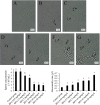Impact of bisphenol-A on the spliceosome and meiosis of sperm in the testis of adolescent mice
- PMID: 35841026
- PMCID: PMC9284711
- DOI: 10.1186/s12917-022-03336-y
Impact of bisphenol-A on the spliceosome and meiosis of sperm in the testis of adolescent mice
Abstract
Background: Bisphenol-A (BPA) has estrogenic activity and adversely affects humans and animals' reproductive systems and functions. There has been a disagreement with the safety of BPA exposure at Tolerable daily intake (TDI) (0.05 mg/kg/d) value and non-observed adverse effect level (5 mg/kg/d). The current study investigated the effects of BPA exposure at various doses starting from Tolerable daily intake (0.05 mg/kg/d) to the lowest observed adverse effect level (50 mg/kg/d) on the testis development in male mice offspring. The BPA exposure lasted for 63 days from pregnancy day 0 of the dams to post-natal day (PND) 45 of the offspring.
Results: The results showed that BPA exposure significantly increased testis (BPA ≥ 20 mg/kg/d) and serum (BPA ≥ 10 mg/kg/d) BPA contents of PND 45 mice. The spermatogenic cells became loose, and the lumen of seminiferous tubules enlarged when BPA exposure at 0.05 mg/kg/d TDI. BPA exposure at a low dose (0.05 mg/kg/d) significantly reduced the expression of Scp3 proteins and elevated sperm abnormality. The significant decrease in Scp3 suggested that BPA inhibits the transformation of spermatogonia into spermatozoa in the testis. The RNA-seq proved that the spliceosome was significantly inhibited in the testes of mice exposed to BPA. According to the RT-qPCR, BPA exposure significantly reduced the expression of Snrpc (BPA ≥ 20 mg/kg/d) and Hnrnpu (BPA ≥ 0.5 mg/kg/d).
Conclusions: This study indicated that long-term BPA exposure at Tolerable daily intake (0.05 mg/kg/d) is not safe because low-dose long-term exposure to BPA inhibits spermatogonial meiosis in mice testis impairs reproductive function in male offspring.
Keywords: Bisphenol-A; DNA damage; RNA-seq; Spliceosome; Synaptonemal complex protein 3 (SCP3); Testis.
© 2022. The Author(s).
Conflict of interest statement
The authors declare that there are no competing interests regarding the publication of this paper.
Figures







Similar articles
-
Hazards of bisphenol A -- blocks RNA splicing leading to abnormal testicular development in offspring male mice.Chemosphere. 2019 Sep;230:432-439. doi: 10.1016/j.chemosphere.2019.05.044. Epub 2019 May 7. Chemosphere. 2019. PMID: 31121507
-
Effects of continuous bisphenol A exposure from early gestation on 90 day old rat testes function and sperm molecular profiles: A CLARITY-BPA consortium study.Toxicol Appl Pharmacol. 2018 May 15;347:1-9. doi: 10.1016/j.taap.2018.03.021. Epub 2018 Mar 26. Toxicol Appl Pharmacol. 2018. PMID: 29596923 Free PMC article.
-
Gestational Exposure to Bisphenol A Affects Testicular Morphology, Germ Cell Associations, and Functions of Spermatogonial Stem Cells in Male Offspring.Int J Mol Sci. 2020 Nov 17;21(22):8644. doi: 10.3390/ijms21228644. Int J Mol Sci. 2020. PMID: 33212759 Free PMC article.
-
Adverse effects of bisphenol A on male reproductive function.Rev Environ Contam Toxicol. 2014;228:57-82. doi: 10.1007/978-3-319-01619-1_3. Rev Environ Contam Toxicol. 2014. PMID: 24162092 Review.
-
Taurine effects on Bisphenol A-induced oxidative stress in the mouse testicular mitochondria and sperm motility.JBRA Assist Reprod. 2020 Oct 6;24(4):428-435. doi: 10.5935/1518-0557.20200017. JBRA Assist Reprod. 2020. PMID: 32550655 Free PMC article. Review.
Cited by
-
SIRT5 is associated with asthenozoospermia and regulates GC‑2 spd cell proliferation and apoptosis.Mol Med Rep. 2025 Oct;32(4):269. doi: 10.3892/mmr.2025.13634. Epub 2025 Jul 25. Mol Med Rep. 2025. PMID: 40709377 Free PMC article.
-
Sex-dependent epigenetic disruption of YY1 binding by prenatal BPA exposure downregulates Matr3 and alters Agap1 splicing in the offspring hippocampus.Biol Sex Differ. 2025 Aug 11;16(1):63. doi: 10.1186/s13293-025-00744-1. Biol Sex Differ. 2025. PMID: 40790242 Free PMC article.
References
-
- Rani M, Shim WJ, Han GM, Jang M, Al-Odaini NA, Song YK, et al. Qualitative analysis of additives in plastic marine debris and its new products. Arch Environ Contam Toxicol. 2015;69(3):352–66. - PubMed
-
- Jandegian CM, Deem SL, Bhandari RK, Holliday CM, Nicks D, Rosenfeld CS, et al. Developmental exposure to bisphenol A (BPA) alters sexual differentiation in painted turtles (Chrysemys picta). Gen Comp Endocrinol. 2015;216:77–85. - PubMed
-
- Zhu Q, Jia J, Zhang K, Zhang H, Liao C. Spatial distribution and mass loading of phthalate esters in wastewater treatment plants in China: an assessment of human exposure. Sci Total Environ. 2019;656:862–69. - PubMed
-
- Srivastava S, Gupta P, Chandolia A, Alam I. SPECIAL REPORT: Bisphenol A: A Threat to Human Health?. J Environ Health. 2015;77(6):20–27. - PubMed
MeSH terms
Substances
Grants and funding
- No.30972208/National Natural Science Foundation of China
- No.30972208/National Natural Science Foundation of China
- No. KX015201/Start-up Project of High-Level Talents Scientific Research in Shihezi University
- No. KX015201/Start-up Project of High-Level Talents Scientific Research in Shihezi University
LinkOut - more resources
Full Text Sources
Miscellaneous

